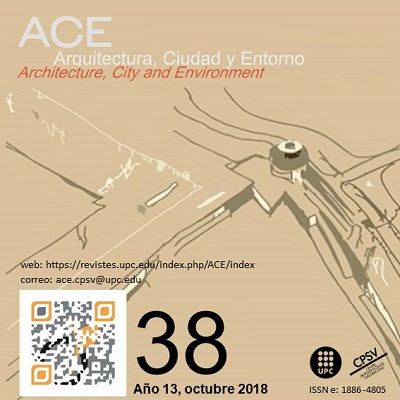Architectural perspectives and photovoltaic roofs in heritage urban contexts
DOI:
https://doi.org/10.5821/ace.13.38.5369Keywords:
Renewables, building integrated photovoltaics, photovoltaic tiles, heritage citiesAbstract
Objective
To estimate electric self-sufficiency through added or integrated photovoltaics (PV) on roofs jointly with heritage and architectural implications analysis. Discussing the impact associated with achieving energy democratization, observing consequences of typical PV technology with crystalline solar cells products, more efficient, mature and economical, compared to new "architectural" PV products developed for mimicry, less efficient, costly, and involving to remove the authentic original coating tiles.
Methodology
Through three-dimensional BIM roof diagrams, the overall solar potential is estimated, and this with respect to own demands. Self-generation margins are projected with locally validated PV production models. Then, through photomontages the relative impact of cristalline PV solar products as well PV tiles, observing the relative impact from different urban perspectives.
Conclusions
PV crystalline solar panels superimposed on roofs could reach electrical surpluses, between four and twenty times. PV roof tiles also would cover a very high demand with substantial surpluses, between two and nine times. From an architectural perspective, it has been shown from urban perspectives, crystalline solar panels are not being noticeable when buildings have more than two floors, but in one floor buildings or from distant and aerial perspectives the impact is significant. From street point of view and urban scale, PV roof tiles, despite having been created for mimicry, also have an effect on one floor buildings, especially in near sight view.
Originality
The originality of this work lies besides estimating the urban solar potential widely analysed in the literature, to counterpose conservation and authenticity aspects, against renewable energy integration consequences. These aspects have not been analysed jointly in the literature so far we know.
Downloads
Published
Issue
Section
License
| INTELECTUAL PROTECTION CRITERIA |
At this moment, it is count with the "Oficina Española de Patentes y Marcas", while global protection it is being processed by the World Intelectual Property Organization (OMPI/WIPO). Nevertheless the International Standard Serial Number Office (ISSN) has given the following numbers ISSN: 1886-4805 (electronic version) and 1887-7052 (paper version). All articles will be peer reviewed, using double blind reviewing. |
| COPYRIGHT |
The article contents and their comments are authors exclusive liability, and do not reflect necessarily the journal editor commitee's opinion. All ACE published works are subject to the following licence CC BY-NC-ND 3.0 ES http://creativecommons.org/licenses/by-nc-nd/3.0/es/ It implies that authors do not hold nor retain the copyright without restrictions but only those included in the licence. |





































